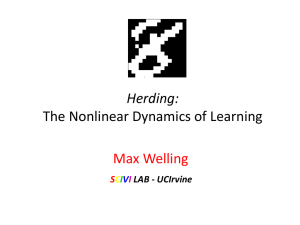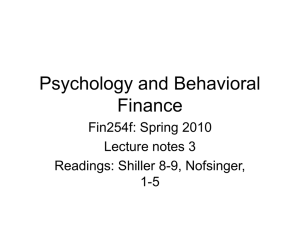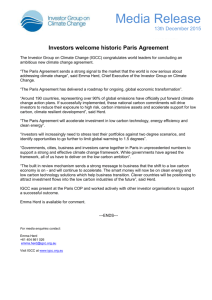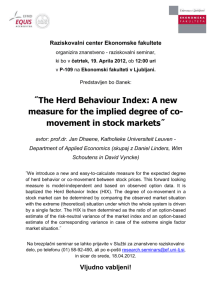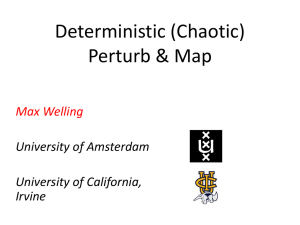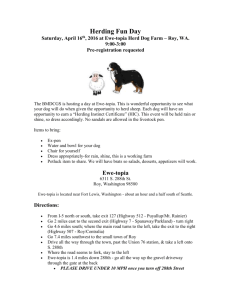Investor Herds in the Taiwanese Stock Market
advertisement
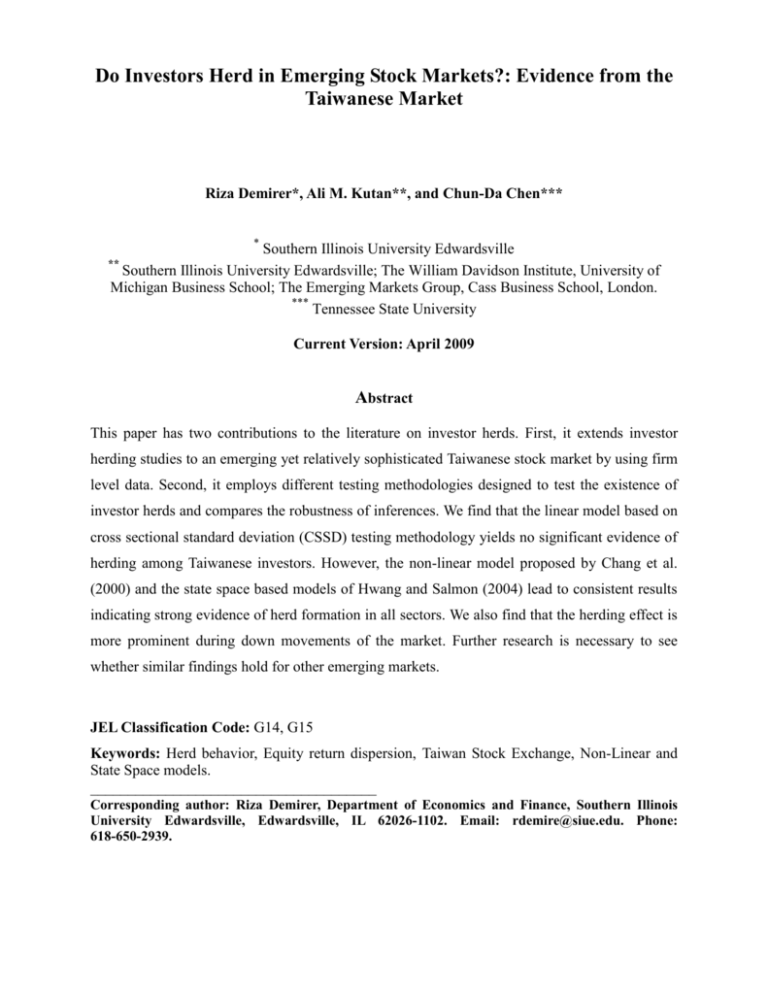
Do Investors Herd in Emerging Stock Markets?: Evidence from the Taiwanese Market Riza Demirer*, Ali M. Kutan**, and Chun-Da Chen*** * Southern Illinois University Edwardsville Southern Illinois University Edwardsville; The William Davidson Institute, University of Michigan Business School; The Emerging Markets Group, Cass Business School, London. *** Tennessee State University ** Current Version: April 2009 Abstract This paper has two contributions to the literature on investor herds. First, it extends investor herding studies to an emerging yet relatively sophisticated Taiwanese stock market by using firm level data. Second, it employs different testing methodologies designed to test the existence of investor herds and compares the robustness of inferences. We find that the linear model based on cross sectional standard deviation (CSSD) testing methodology yields no significant evidence of herding among Taiwanese investors. However, the non-linear model proposed by Chang et al. (2000) and the state space based models of Hwang and Salmon (2004) lead to consistent results indicating strong evidence of herd formation in all sectors. We also find that the herding effect is more prominent during down movements of the market. Further research is necessary to see whether similar findings hold for other emerging markets. JEL Classification Code: G14, G15 Keywords: Herd behavior, Equity return dispersion, Taiwan Stock Exchange, Non-Linear and State Space models. ______________________________________ Corresponding author: Riza Demirer, Department of Economics and Finance, Southern Illinois University Edwardsville, Edwardsville, IL 62026-1102. Email: rdemire@siue.edu. Phone: 618-650-2939. 1. Introduction Formation of investor herds has been proposed as an alternative explanation of how investors process information and make investment choices. Herding is simply defined as an investment strategy based on mimicking other investors’ actions or the market consensus (e.g., Bikhchandani and Sharma, 2000).1 One of the main contributions of this study is to extend herding tests to the Taiwanese stock market. The second main contribution is to employ different herding methodologies proposed in the literature and to provide robustness tests. We select the Taiwanese stock market for several reasons. First, as shown in Table 1, domestic investors, mostly individual, account for the highest percentage of total investment amount in all sectors with the exception of electronics. So, this is a market dominated by domestic individual investors, rather than institutional and foreign investors. However, the table also suggests an increasing interest by foreign investors over the past six years, especially in electronics. Unlike investment trusts, foreign investors, and security dealers, most individual investors tend to have less professional knowledge and cannot access information accurately and easily. In a market dominated by domestic individual investors with limited access to information, one might argue that the resulting information asymmetry may lead these individual investors to follow the actions of other investors including more informed institutional and foreign investors. For this reason, one might expect the formation of investor herds in this market dominated by the less informed domestic individual investors. For this purpose, it is especially interesting to examine whether herd formation exists in the Taiwanese market with this unique characteristic. 1 Prior studies differ in their explanation to what might trigger such behavior. Devenow and Welch (1996) use the arguments of investor psychology where investors feel a sense of security in following the crowd. Another view suggests that the actions of more informed traders may reveal useful information which may not be accessible to individual investors (Chari and Kehoe, 1999, Calvo and Mendoza, 1998, and Avery and Zemsky, 1998). Finally, a third approach focuses on the principal-agent relationship where fund managers might want to imitate others as a result of the incentives provided by the compensation scheme or in order to maintain their reputation (Scharfstein and Stein, 1990, Rajan, 1994, and Maug and Naik, 1996). 2 Second, despite being an emerging market, the Taiwanese stock market is highly developed. The ratio of average stock market total value to GDP, a commonly used measure of stock market development, in Taiwan during the period from 1975 to 2006 was 1.65, which is greater than that of the U.S. (1.25) and ranked first among 75 countries during this period.2 If the results indicate evidence of herding, this suggests that herding may take place in a relatively developed yet still an emerging stock market like Taiwan. Third, there is limited and conflicting evidence on herding behavior in the Taiwanese stock market. To our best knowledge, there are only two empirical studies of herding behavior in the Taiwanese stock market. Using one of the methodologies employed in this paper, Chang et al. (2000) analyze daily equally-weighted index return data from January 1976 to December 1995 and find significant evidence of herding in this market. However, their study examines firm level return data within the market portfolio without classifying individual firms into specific sectors. As Bikhchandani and Sharma (2000) suggest, herd formation would be more likely to occur at the level of investments in a group of stocks such as stocks in an industry where investors face similar decision problems and can observe the trades of others in the group. Lin and Swanson (2003) also study herd behavior of investors in the Taiwanese stock market during 1996-2003 period again using one of the methodologies we employ here, but they focus only on foreign investors and the most liquid stocks without classifying them into sector groups. They find no evidence that foreign investors herd in this market. Overall, we can conclude that there is no study of herding behavior in Taiwan covering the more recent period and the available studies produce conflicting findings. As Table 1 shows, studying the more recent period is important due to the increase participation of foreign investors. Given different findings and limited work on Taiwan and the interesting institutional characteristic of this market (i.e., a large number of domestic individual investors with a small 2 See Beck, Demirguc-Kunt and Levine (2000). 3 but growing number of foreign investors), we extend the earlier studies in three significant aspects by (i) providing sector-specific evidence, (ii) employing different testing methodologies, and (iii) providing evidence using recent daily data from January 1995 to December 2006. We employ two major different testing methodologies based on the dispersions of returns and factor sensitivities, and compare the inferences from each model using a large scale data. The findings have implications for the robustness of different herding tests used in the literature. Previous studies hypothesize that herding behavior may be captured by either return dispersions or relative dispersion of the time-varying betas for assets. For the former, we employ linear and non-linear models based on “return dispersions” among individual firms; more specifically, cross sectional standard deviations (CSSD) and cross sectional absolute deviations (CSAD) across a particular sector. For the latter, we employ models based on a state space model specification proposed by Hwang and Salmon (2004). These two sets of models differ in the sense that the first two focus on the cross-sectional variability of returns, whereas the last two focus on the cross-sectional variability of factor sensitivities. Understanding which models yield herding behavior may provide information about the ways in which investors herd. These models are summarized in Section 3. Looking forward, we find no significant herding behavior based on the linear model. This is consistent with our finding of significant non-linear effects in the data, making the inferences from the linear model spurious. However, the non-linear model and the state space based models lead to consistent results, indicating strong evidence of herd formation in all sectors analyzed, suggesting that herding behavior may be captured by examining either cross-sectional return dispersions in a non-linear fashion or beta dispersions. In Section 2, we briefly summarize previous studies on tests of investor herds as well as a summary of market efficiency studies on the Taiwanese stock market. Section 3 provides the details of different testing methodologies employed and data description. Section 4 presents 4 empirical results and a comparison of the findings from the return dispersion based models and state space models. Finally, Section 5 concludes the paper and proposes further research. 2. Previous Studies on Investor Herds Different methodologies have been suggested in the literature to test the existence of investor herds. Testing methodologies based on return dispersions among a group of securities focus on cross sectional standard (or absolute) deviations of returns. Prior studies include Christie and Huang (1995) on U.S. equities, Chang, Cheng and Khorana (2000) on international equities, Gleason, Lee and Mathur (2003) on commodity futures traded on European exchanges, Gleason, Mathur and Peterson (2004) on Exchange Traded Funds, and Demirer and Kutan (2006) and Tan et al. (2008) on Chinese stocks. With the exception of Tan et al. (2008), prior studies generally provide results in favor of the rational asset pricing theories and conclude that herding is not an important factor in determining security returns during periods of market stress. In a limited study using sixty highest capitalization stocks held by foreign investors in Taiwan, Lin and Swanson (2003) employ the cross sectional standard deviation based methodology and find no evidence that foreign investors herd in this market. A different testing methodology based on cross sectional variability of factor sensitivities, instead of returns, is suggested by Hwang and Salmon (2004). Their analysis of daily stock returns in the South Korean market provides support for herd formation in this market. Extending the study to futures markets, Weiner and Green (2004) employ both parametric and non-parametric methodologies and find little evidence of herding in heating oil and crude-oil futures. In a more recent study, Uchida and Nakagawa (2007) use the LSV herding measure of Lakonishok, Shleifer, and Vishny (1992) to test herd behavior in the domestic loan market for Japanese banks and find evidence of herd behavior among regional banks and among geographically proximate banks. The efficient market hypothesis (EMH) suggests that asset prices reflect all available 5 information processed by rational investors who make investment decisions based on their independent research of these assets. In that sense, formation of investor herds can be considered as an alternative investment behavior which might lead to an inefficient market where asset prices show significant deviations from what one would expect in an efficient market. This clearly is a significant concern for not only traders in the market but also for policy makers as such behavior would lead to unnecessary volatility and more frequent extreme observations. The efficiency of the Taiwanese stock market has been the topic of several studies in the literature. Lee et al. (2004) classify this market as a semi-strong efficient market, observing that institutional investors and informed investors can earn excess returns when they receive private signals. In an earlier study, using Sherry’s (1992) non-parametric methods to examine the efficiency of six Asian stock markets, Los (2001) concludes that Taiwan’s stock market lacks at least one of the two required fair game attributes, and accordingly, the efficient market hypothesis must be rejected for this market. Separately, Yu and Huang (2004) examine the statistical properties of volatility among New York and five stock markets in Asia and find that Taiwan is the most volatile market among the six stock markets studied. In an earlier study, Titman and Wei (1999) compare Korean and Taiwanese stock markets and find that the Taiwanese market has been the more volatile one despite the similarities between these the two markets. They note the higher trading volume in the Taiwanese market and link the high volatility in this market to the volatile nature of underlying fundamentals. Although their analysis rejects the notion that excessive speculation is the source of high volatility in this market, they acknowledge that stock prices may have deviated from fundamental values at selected times. Consistent with these findings, Leung, Daouk and Chen (2006) characterize the Taiwanese market as highly volatile, having relatively smaller capitalization, and less price efficient. Finally, Lim, Brooks, and Hinich (2007) utilize the bi-correlation statistics of Hinich (1996) and find that the Taiwan Stock Exchange weighted 6 index has no clear trend towards higher efficiency as predicted by the classical efficient market hypothesis. Overall, the empirical evidence summarized above indicates that Taiwan’s stock market is not yet informationally efficient as defined by the EMH. Our study, in that respect, can be viewed as an extension of market efficiency studies in this market as the existence of herd formation would clearly indicate violation of the assumptions for an efficient market in which prices fully and instantaneously reflect all available information. 3. Methodology We employ two testing methodologies: return dispersion based models and state space models. This section summarizes the methodology for each testing methodology. 3.1 Return Dispersion Models The first two testing methodologies employed are based on cross sectional standard deviations (CSSD) and cross-sectional absolute standard deviations (CSAD) among individual firm returns within a particular group of securities. Christie and Huang (1995) use CSSD as a measure of the average proximity of individual asset returns to the realized market average in order to test herd behavior. Chang et al. (2000) use CSAD in a non-linear regression specification in order to examine the relation between the level of equity return dispersions and the overall market return. The first return dispersion methodology employed in this study is based on return dispersions as measured by CSSD. This methodology has been used by Christie and Huang (1995), Chang, Cheng, and Khorana (2000), Gleason, Lee and Mathur (2003), Lin and Swanson (2003), Gleason, Mathur and Peterson (2004), and Demirer and Kutan (2006). Cross-sectional standard deviations (CSSD), used as a measure of return dispersion, is formulated as follows: 7 N CSSDt r i, t rp , t 2 i 1 N 1 (1) where n is the number of firms in the aggregate market portfolio, ri ,t is the observed stock return on firm i for day t and r p ,t is the cross-sectional average of the n returns in the market portfolio for day t. This measure can be regarded as a proxy to individual security return dispersion around the market average. The main idea in this methodology is based on the argument that the presence of herd behavior would lead security returns not to deviate far from the overall market return. The rationale behind this argument is the assumption that individuals suppress their own beliefs and make investment decisions based solely on the collective actions of the market. On the other hand, rational asset pricing models offer a conflicting prediction suggesting that dispersions will increase with the absolute value of market return since each asset differs in its sensitivity to the market return. This methodology also suggests that the presence of herd behavior is most likely to occur during periods of extreme market movements, as they would most likely tend to go with the market consensus during such periods. Hence, we examine the behavior of the dispersion measure in (1) during periods of market stress and estimate the following linear regression model: CSSDt D DtL U DtU t (2) where DtL = 1, if the return on the aggregate market portfolio on day t lies in the lower tail of the return distribution; 0 otherwise, and D tU = 1, if the return on the aggregate market portfolio on day t lies in the upper tail of the return distribution; 0 otherwise. Although somewhat arbitrary, in the literature, an extreme market return is defined as one that lies in the one (and five) percent lower or upper tail of the return distribution. 8 The dummies in equation (2) aim to capture differences in return dispersions during periods of extreme market movements. As herd formation indicates conformity with market consensus, the presence of negative and statistically significant D (for down markets) and U (for up markets) coefficients would indicate herd formation by market participants. The second return dispersion methodology employed in this paper is suggested by Chang et al. (2000) and uses the cross-sectional absolute deviation of returns (CSAD) as a measure of return dispersion. CSAD is expressed as CSADt 1 N N | r i, t rm , t | (3) i 1 Chang et al. (2000) challenge the CAPM assumption that return dispersions are an increasing function of the market return and that this relation is linear. If there are significant non-linear effects, then the results based on the cross sectional standard deviations of returns would not be valid. The authors suggest that during periods of market stress, one would expect the relation between return dispersion and market return to be non-linearly increasing or even decreasing. Therefore, they propose a testing methodology based on a general quadratic relationship between CSADt and rm,t of the form: CSADt 1 rm.t 2 rm2.t t (4) According to this methodology, herding would be evidenced by a lower or less than proportional increase in the cross-sectional absolute deviation (CSAD) during periods of extreme market movements. As a result, if herding is present, then the non-linear coefficient, γ2 will be negative and statistically significant; otherwise a statistically positive γ2 would indicate no evidence of herding. 3.2 State Space Models The next testing methodology we employ is suggested by Hwang and Salmon (2004). Rather than returns, Hwang and Salmon (2004) focus on the cross-sectional variability of factor 9 sensitivities. Considering a one factor model with the factor being the market return, they formulate a herding measure based on the relative dispersion of the betas for all assets in the market. Next, we briefly explain this methodology. Consider the following CAPM in equilibrium, Er (rit ) imt Et (rmt ) (5) where rit and rmt are the excess returns on asset i and the market at time t , respectively, imt is the systematic risk measure, and E t () is conditional expectation at time t . In equilibrium, we only need to price an asset i . When herding behavior is present, investors disregard the equilibrium relationship of Equation (5) and trade in such a way that matches individual asset returns with that of the market. When that happens, the term and the expected rate of return present a bias which reflects this matching of individual asset returns with that of the market. So, considering CAPM again, when herding behavior is present, real coefficient obeys the following relation which replaces equation (5): Etb (rit ) b imt imt hmt ( imt 1) , Et (rmt ) (6) b where Etb (rit ) and imt are the market’s biased short run conditional expectation on the excess returns of asset i and its beta at time t , and hmt is a latent herding parameter that changes over time, hmt 1 , and conditional on market fundamentals. In general, when (0 hmt 1) , one could argue that some degree of herding exists in the market determined by the magnitude of hmt . Since the form of herding we discuss represents market-wide behavior and Equation (6) is assumed to hold for all assets in the market, the level of herding is estimated using all assets in the market rather than a single asset, thereby removing the effects of idiosyncratic movements in b b any individual imt . The standard deviation of imt is then formulated as 10 b Stdc ( imt ) Ec (( imt hmt ( imt 1) 1) 2 ) Ec (( imt 1) 2 ) (1 hmt ) Std c ( imt )(1 hmt ) , (7) where E C () represents the cross-sectional expectation. Taking the logarithm of Equation (7) b ) can be time-varying over a time interval in response to the level and assuming that Std c ( imt of herding in the market, we rewrite Equation (7) as b log[ Std c ( imt )] m mt where m E[log[ Std c ( imt )]] and mt ~ iid (0, m2 ) . State Space Model 1 is then estimated as b log[ Std c ( imt )] m H mt mt , (8) H mt m H mt 1 mt , (9) where H mt log( 1 hmt ) and mt ~ iid (0, m2 ) . Equations (8) and (9) are the standard state-space model with Kalman filter estimation. In this methodology, we only focus on the dynamic pattern of movements in the latent state variable, H mt , the state equation. When m2 0 , there is no herding which implies that H mt 0 for all t . The model allows herding, H mt , to evolve over time and follow a dynamic process. A significant value of m2 can be interpreted as the existence of herding and a significant supports this particular autoregressive structure. An alternative, augmented model can be formulated when we add to Equation (8) market volatility, log mt , and return , rmt , as independent variables. This leads to State Space Model 2 formulated as b log[ Std c ( imt )] m H mt c m1 log mt c m 2 rmt mt . (10) 11 Similarly, a significant value of m2 can be interpreted as the existence of herding and a significant supports this particular autoregressive structure. 4. Data and Empirical results 4.1 Data The data set used in this study contains daily returns for 689 Taiwanese stocks traded on the Taiwan Stock Exchange over the January 1995December 2006 period. Data are obtained from the Taiwan Stock Exchange Corporation (TSEC). Herding tests in the literature are based on the suggestion that a group is more likely to herd if it is sufficiently homogeneous, i.e., each member faces a similar decision problem, and each member can observe the trades of other members in the group (Bikhchandani and Sharma, 2000). Prior studies have, therefore, applied the tests on groups of stocks categorized on the basis of industry classification (e.g., Christie and Huang, 1995), exchange or country assignment (e.g. Gleason, Mathur and Peterson, 2004 and Chang, Chen, and Khorana, 2000). Following these studies, we assign each of the 689 firms to one of eighteen sector groups including Cement, Food, Plastics, Textile, Electrical Appliances, Wire & Cable, Chemicals, Glass & Ceramics, Pulp & Paper, Steel, Rubber, Automobile, Electronics, Construction, Transportation, Tourism, Banking & Securities, and Retailing. We then calculate portfolio returns based on an equally weighted portfolio of all firms in each sector classification. Table 2 provides summary statistics for average daily log returns, return dispersions, and the average number of firms used to compute these statistics for each sector. Since the number of stocks in a sector does not stay constant over time, we report the average number of firms over the sample period in the second column of Table 2. Examining Table 2, we observe that the average daily returns for all sectors are positive and electronics and construction sectors have the highest average daily volatility. Panel B in Table 2 reports summary statistics for daily cross sectional standard deviations within each sector. Consistent with the findings from Panel A, we 12 observe the highest cross sectional volatility in Electronics followed by Construction.3 4.2 Results of return dispersion models Table 3 presents estimation results for the CSSD based model in Equation 2. Given the significant variation in dispersions and strong correlation, all estimations are done using the Newey-West heteroskedasticity and autocorrelation consistent standard errors 4 . We use the Taiwan Stock Exchange Composite Index to represent the market and use the upper and lower one and five percentiles of the market return to represent periods of market stress. For a majority of the sectors analyzed, we do not find any evidence in favor of herd formation during periods of large market swings. This finding is consistent with Lin and Swanson (2003) who tested whether foreign investors herd in the Taiwanese stock market using the same methodology. Similar to their findings, our regressions yield statistically significant and positive estimates indicating that equity return dispersions increase during periods of large price changes as predicted by CAPM. However, estimations across sector groups indicate that the only exception to this is Electronics where we observe significantly lower return dispersions when market is in the upper or lower one percentile, indicating herd formation during extreme moves of the market index. Table 4 presents estimations results for the non-linear CSAD based model in Equation 4. Following Chang et al. (2000), we run three separate regressions for each sector: one using the whole sample, and two restricting the data to up (or down) movements of the market index. Running separate models in this manner allows us to examine whether there is any asymmetric effect of herd behavior. Our findings with the non-linear model lead to completely different results than the first methodology. 3 Over the past few years, the electronics sector has shown rapid growth. According to the annual report of Taiwan Stock Exchange Corporation, this sector accounts for 60% and 70% of the total volume and value of the Taiwan stock market, respectively. Regarding the construction sector, the government of Taiwan has executed different policies frequently to stimulate growth in the housing market. Such governmental intervention policy might have led to the higher returns and corresponding higher volatility in this sector. 4 We also estimated the models using GARCH models; the results were qualitatively the same. 13 Focusing on Table 4, we first note that the nonlinear term (γ2) is statistically significant almost in all cases, suggesting that inferences from the linear model reported in Table 3 are spurious. We therefore heavily rely on the non-linear tests reported in Table 4 to make inferences about herding. Indeed, we find evidence to herd formation in Table 4 in all sectors, except for Tourism and Automobile. The regressions yield statistically significant and negative γ2 estimates indicating a non-linear and decreasing relation between equity return dispersions and the market return. However, when we examine regression results run with data restricted to up and down markets separately, we observe that herding effect is mostly prominent during market losses. The results suggest that t is more likely to observe herd formation during periods of market losses.5 4.3 Results of state space models Table 5 presents estimation results for State Space Model 1. Consistent with our findings from the non-linear model, the results indicate strong evidence of herding through H mt . We observe that H mt is highly persistent with large and significant values of ˆm . More importantly, the estimates for m are highly significant providing support for herd behavior. Table 6 presents estimation results for State Space Model 2. Compared with State Space Model 1, Model 2 contains two market variables – market volatility and market return. The addition of these two variables in the measurement equation allows us to analyze the degree of herding, given the state of the market. Our findings are similar to those we observe with the first state space model results in Table 5. Once again, taking into account the level of market volatility and return this time, we find that the term H mt is still significant when these two explanatory variables are included. This finding suggests that changes in the volatility of factor b ) , could be explained by herding rather than changes in fundamentals. sensitivities, Std c ( imt 5 This finding is consistent with some of the behavioral finance literature suggesting the concept of loss aversion. According to this theory, investors’ utility function is formed in such a way that investors have a greater tendency towards avoiding losses than acquiring gains (see for example Kahneman and Tversky, 1979 and Tversky and Kahneman, 1991). Therefore, the finding that investors herd during periods of market losses can be due to investor psychology leading to asymmetric responses to up and down markets. 14 Furthermore, we estimate significant and negative coefficients for the term log mt for Plastics, Electrical App., Chemicals, Pulp, Steel, Automobile, Tourism, and Retailing sectors, indicating b ) , decreases with market volatility. These that the volatility of factor sensitivities, Std c ( imt results are consistent with previous studies which suggest that herding is more likely to occur during periods of market stress, i.e. highly volatile periods. However, in the case of Cement, Food, Textile, Wire & Cable, Glass, Electronics, and Banking & Securities sectors in Table 6, our findings suggests that the volatility of factor b ) , increases as market volatility rises since the coefficients for the market sensitivities, Std c ( imt volatility term ( log mt ) have significant and positive values. Interestingly, the majority of these sectors where factor sensitivities increase with market volatility also have relatively higher foreign shareholding percentage (Table 1). Thus, we believe that investors in these sectors may exhibit herding behavior regardless of the level of market conditions, as signals from a significant body of foreign investors in these sectors may be stronger or more visible to domestic individual investors. Furthermore, comparing the estimates for ˆm across sectors we notice that the effect of herd behavior in Electronics is relatively higher compared to other sectors. Once again, examining Table 1, we note that Electronics sector stands out among other sectors with the strongest presence of foreign investors. It is also interesting to note that the Electronics sector is the largest sector with 307 firms (Table 2), accounting for 60% and 70% of the total volume and value of the entire Taiwan stock market, respectively. 5. Conclusions and suggestions for further research There are scant studies on herding behavior in Taiwan and they produce conflicting inferences and do not provide evidence at the sector level. In this paper, we extend tests of investor herds to the Taiwan Stock Exchange, using firm level data on 689 firms classified into 18 different 15 sectors. Also, we employ different herding models simultaneously using a large data set to compare and contrast inferences under different approaches to testing the formation of investor herds. The linear model proposed by Christie and Huang (1995) provides no evidence of investor herds, except for the Electronics sector. However, we find that the assumption of linearity between return dispersions and the market return in this methodology yields unreliable results as our tests of the non-linear model suggests significant non-linear effects. Extending our tests to the non-linear model proposed by Chang et al. (2000), which assumes that return dispersion and market return to be non-linearly related, indicates herding in all sectors analyzed. We find significant non-linear effects, suggesting that inferences from the Chang et al. (2000) model yields more reliable inferences on herding. Our tests of factor sensitivities using the state space based models proposed in Hwang and Salmon (2004) further support the results of the non-linear model, indicating robust evidence of herd formation in Taiwan across all sectors. This is the initial study comparing the inferences from different empirical models of herding. It would be interesting to see whether similar results would hold when the same tests are applied to different emerging markets or developing and developed markets.. Our results, which are based on dispersions of returns and factor sensitivities, should be interpreted cautiously, however, as there are other tests of herding formation. It would be interesting to compare our findings with those from different herd-formation methodologies such as those on trading data. 16 References Avery, C. and Zemsky, P., 1998. Multidimensional Uncertainty and Herd Behavior in Financial Markets. American Economic Review 88, 724-748. Beck, T., Demirgüç-Kunt, A. and Levine, R., 2000. A New Database on Financial Development and Structure. World Bank Economic Review 14, 597-605. Bikhchandani, S. and Sharma, S., 2000. Herd Behavior in Financial Markets: A Review. IMF Working Paper WP/00/48 (Washington: International Monetary Fund). Calvo, G.. and Mendoza, E., 1998. Rational Herd Behavior and Globalization of Securities Markets. Mimeo, University of Maryland. Chang, E. C., Cheng, J. W., and Khorana, A., 2000. An Examination of Herd Behavior in Equity Markets: An International Perspective. Journal of Banking and Finance 24, No. 10, 1651-1699. Chari, V. V. and Kehoe, P., 1999. Financial Crises as Herds. Mimeo, Federal Reserve Bank of Minneapolis. Christie, W. G. and Huang, R. D., 1995. Following the Pied Piper: Do individual Returns Herd around the Market? Financial Analyst Journal, July-August , 31-37. Demirer, R. and Kutan, A. M., 2006, Does Herding Behavior Exist in Chinese Stock Market? Journal of International Financial Markets, Institutions and Money 16, 123-142. Devenow, A. and Welch, I., 1996. Rational Herding in Financial Economics, European Economic Review 40, 603-615. Gleason, K. C., Lee, C. I., and Mathur, I., 2003. Herding Behavior in European Futures Markets. Finance Letters 1, 5-8. Gleason, K. C., Mathur, I., and Peterson, M. A., 2004. Analysis of Intraday Herding Behavior among the Sector ETFs. Journal of Empirical Finance 11, 681–694. Hinich, M. J., 1996. Testing for Dependence in the Input to a Linear Time Series Model. Journal of Nonparametric Statistics, 6, 205-221. Hwang, S., and Salmon, M., 2004, Market Stress and Herding, Journal of Empirical Finance 11, 585-616. Kahneman, D. and Tversky, A., 1979. Prospect Theory: An Analysis of Decision under Risk. Econometrica 47, 263-291. Lakonishok, J., Shleifer, A., and Vishny, R. V., 1992. The Impact of Institutional Trading on Stock Prices. Journal of Financial Economics 32, 23-43. 17 Lee, Y.-T., Liu, Y.-J., Roll, R., and Subrahmanyam, A., 2004. Order Imbalances and Market Efficiency: Evidence from the Taiwan Stock Exchange, Journal of Financial and Quantitative Analysis 39, 327-341. Leung, M. T., Daouk, H., and Chen, A.-S., 2006. Application of Neural Networks to an Emerging Financial Market: Forecasting and Trading the Taiwan Stock Index. Computers and Operations Research 30, 901-923. Lim, K.-P., Brooks, R. D., and Hinich, M., 2007. Nonlinear Serial Dependence and the Weak-form Efficiency of Asian Emerging Stock Markets, Forthcoming in Journal of International Financial Markets, Institutions, and Money. Lin, A. Y., and Swanson, P. E., 2003. The Behavior and Performance Foreign Investors in Emerging Equity Markets: Evidence from Taiwan. International Review of Finance, 4:3–4, 189–210. Los, C. A., 2001. Nonparametric Efficiency Testing of Asian Stock Markets Using Weekly Data. Centre for Research in Financial Services Working Paper No. 99-01. Maug, E. and Naik, N., 1996. Herding and Delegated Portfolio Management. Mimeo, London Business School. Rajan, R. G., 1994. Why Credit Policies Fluctuate: A Theory and Some Evidence. Quarterly Journal of Economics 436, 399-442. Scharfstein, D. and Stein, J., 1990. Herd Behavior and Investment. American Economic Review 80, 465-479. Sherry, C. J., 1992. The Mathematics of Technical Analysis: Applying Statistics to Trading Stocks, Options and Futures. Probus Publishing Co., Chicago, IL. Tan, L., Chiang, T. C., Mason, J. R., and Nelling, E., 2008. Herding Behavior in Chinese Stock Markets: An Examination of A and B Shares. Pacific-Basin Finance Journal 16, 61–77. Titman, S., and Wei, K.C. J., 1999. Understanding Stock Market Volatility: The Case of Korea and Taiwan. Pacific-Basin Finance Journal 7, 41–66. Tversky, A. and Kahneman, D., 1991. Loss Aversion in Riskless Choice: A Reference Dependent Model. Quarterly Journal of Economics 106, 1039-1061. Uchida, H. and Nakagawa, R., 2007. Herd Behavior in the Japanese Loan Market: Evidence from Bank Panel Data. Journal of Financial Intermediation 16, 555-583. Weiner, R. J. (2006). “Do Birds of a Feather Flock Together? Speculator Herding in the World Oil Market.” Discussion paper. Resources for the Futures, RFF DP 06-31. 18 Yu, H.-C. and Huang, M.-C., 2004. Statistical Properties of Volatility in Fractal Dimension and Probability Distribution among Six Stock Markets. Applied Financial Economics 14, 1087-1095. 19 Table 1. Shareholding Percentage of Market Participants by Sector (%) Domestic Year Individual 1996 2001 2006 90.33 94.63 75.42 1996 2001 2006 88.49 85.87 81.50 1996 2001 2006 89.24 94.74 80.94 1996 2001 2006 92.38 87.58 77.33 1996 2001 2006 80.46 74.94 57.57 1996 2001 2006 89.66 89.28 76.52 1996 2001 2006 85.85 85.98 72.95 Domestic Institution Cement 0.87 0.80 0.91 Textiles 1.09 1.47 0.97 Chemicals 1.91 3.17 1.58 Steel 0.11 0.18 1.08 Electronics 1.32 2.49 0.59 Tourism 0.17 0.12 1.97 Others 2.17 2.97 1.45 Foreign Investor 8.80 4.57 23.67 10.43 12.67 17.53 8.85 2.09 17.49 7.51 12.24 21.59 18.22 22.57 41.84 10.17 10.61 21.52 Domestic Individual Domestic Foreign Institution Investor Food 90.13 0.63 9.24 92.62 0.55 6.83 74.99 0.90 24.11 Electrical App. 86.02 2.03 11.96 89.93 1.93 8.15 81.26 2.42 16.32 Glass 90.83 0.33 8.84 95.64 0.72 3.64 94.39 0.28 5.33 Rubber 89.19 1.77 9.04 93.66 2.19 4.16 87.97 2.00 10.03 Construction 91.90 1.46 6.64 95.73 0.55 3.72 87.80 1.89 10.31 Banking & Securities 94.71 0.78 4.52 90.52 0.89 8.59 73.26 1.06 25.68 Domestic Individual Foreign Investor 81.58 81.89 82.54 17.95 17.60 16.93 85.84 90.67 77.43 86.67 93.29 88.64 71.63 76.39 74.44 83.43 84.89 79.63 90.66 77.97 71.95 Domestic Institution Plastics 0.47 0.52 0.53 Wire & Cable 0.57 0.55 0.66 Pulp & Paper 0.75 0.40 0.83 Automobile 0.54 0.66 1.44 Transportation 0.39 0.59 1.19 Retailing 1.13 1.07 0.81 13.59 8.78 21.91 12.58 6.31 10.53 27.83 22.95 24.12 16.18 14.52 19.18 8.21 20.96 27.24 11.98 11.05 25.61 20 Table 2. Summary Statistics: Average Daily Returns and Cross-Sectional Standard Deviations. Industry # Firms # Obs. Mean Std. Dev. Panel A: Average Daily Return Cement 8 3154 0.016% 2.457% Food 18 3154 0.026 2.404 Plastics 20 3154 0.028 2.735 Textiles 47 3154 0.014 2.773 Electrical App 36 3154 0.040 2.506 Wire & Cable 14 3154 0.021 2.670 Chemicals 35 3154 0.035 2.476 Glass and Ceramics 7 3154 0.003 3.019 Pulp & Paper 7 3154 0.017 2.707 24 3154 0.043 2.827 Rubber 9 3154 0.044 2.723 Automobile 5 3154 0.056 2.212 Electronics 307 3154 0.056 3.106 Construction 34 3154 0.051 3.183 Transportation 18 3154 0.049 2.641 6 3154 0.039 2.486 Banking & Securities 45 3154 0.019 2.426 Retailing 10 3154 0.040 2.433 Others 39 3154 0.049 2.498 Panel B: Cross-Sectional Standard Deviation Steel Tourism Cement 1.558% 0.811% Foods 1.868 0.705 Plastics 1.895 0.725 Textile 2.119 0.608 Electrical App 2.015 0.648 Wire and Cable 1.956 0.790 Chemicals 1.923 0.638 Glass and Ceramics 2.299 1.084 Pulp and Paper 1.690 0.815 Steel 1.917 0.736 Rubber 1.914 0.843 Automobile 1.405 0.888 Electronics 2.433 0.920 Construction 2.324 0.730 Transportation 1.868 0.731 Tourism 1.655 0.843 Banking & Securities 1.644 0.639 Retailing 1.845 0.778 Others 2.073 0.590 21 Table 3. Regression Coefficients for CSSDt D DtL U DtU t (t-ratios in parentheses). Return Dispersions Industry Cement Food Market return in the extreme upper/lower 1% of the return distribution D U 1.553% 1.857 0.245% 0.294%** (1.532) *** 0.699 (4.812) Plastics Textile Electrical App. 1.893 2.116 2.009 Chemicals 1.955 1.919 Pulp and Paper Steel Rubber Automobile 2.296 1.691 1.914 1.916 1.395 Construction Transportation Tourism 2.330 2.319 1.862 1.641 1.639 Others 1.841 2.067 (4.563) *** 0.351*** (8.979) (7.005) *** 0.260*** 0.442 1.824 (4.004) 1.857 0.541 (7.580) (5.704) * *** 0.242*** 0.149 (1.014) (1.840) (6.507) (6.433) * *** *** 0.285*** (6.727) (6.954) *** 0.238*** (4.530) (4.001) *** 0.193*** (8.739) (4.764) *** 0.403*** (4.313) 0.243 0.304 0.016 (0.512) (0.117) 0.379 1.980 (3.449) 0.089 *** 2.090 0.498 0.146 1.928 0.043 1.890 (0.629) 2.262 0.339 0.402 0.322 0.476 0.089 0.186 (0.334) (0.899) (3.394) *** -0.0002 -0.073 (-0.001) (-0.523) 0.086 0.165 (0.724) 1.670 0.331 0.307 0.099 (4.245) (1.612) 0.404*** 0.313*** (1.488) (6.770) (5.814) * *** 0.113* 1.881 0.061 -0.219 (0.277) (-1.661) (5.214) (1.902) * *** *** 0.285*** (5.777) (3.920) 0.392 -0.389 *** 0.569 -0.485 *** 1.367 0.479 0.069 -0.012 (-0.260) 0.257*** 0.257*** (2.388) (4.441) (5.262) * *** 0.283*** 0.217 0.274** (1.424) ** 0.197 2.319 0.456 (1.245) (-5.340) 0.426 1.886 (3.423) (-3.111) 2.299 1.828 0.514 (2.541) (1.945) (8.813) (5.951) *** *** *** 0.344*** (6.480) (5.384) *** 0.326*** (6.306) (7.047) *** 0.249*** 0.838 0.320 ** (2.559) Retailing (5.057) *** (0.314) (3.574) Banking & Securities (2.053) (1.019) (1.947) Electronics 0.269%*** 0.026 (2.649) Glass and Ceramics 0.353%*** 1.527% 0.168 (1.646) Wire and Cable Market return in the extreme upper/lower 5% of the return distribution D U 0.350 ** 0.542 1.609 (4.162) 0.135 1.610 (1.090) 0.100 1.811 0.564 0.359 0.448 (2.497) (1.177) (7.214) (5.435) *** *** *** 0.221*** (9.346) (5.410) 0.348 0.210 (3.019) (2.418) (***, **, and * denote statistical significance at 1%, 5%, and 10%, respectively) 2.041 0.418 22 Table 4. Regression Coefficients for CSADt 1 rm.t 2 rm2.t t (t-ratios in parentheses). Absolute Deviation Industry Whole Sample α γ1 Down Market (Rm<0) γ2 α γ1 γ2 0.162*** -0.018*** 1.002 0.217*** -0.029*** (5.993) (-2.691) (6.050) (-3.637) *** ** *** Food 1.196 0.193 -0.013 1.173 0.265 -0.024*** (7.913) (-2.050) (8.051) (-3.030) *** *** *** Plastics 1.211 0.304 -0.043 1.188 0.381 -0.056*** (11.281) (-6.643) (10.103) (-6.143) *** *** Textile 1.393 0.229 -0.030 1.370 0.281*** -0.039*** (9.322) (-4.774) (8.065) (-4.392) Electrical App. 1.324 0.206*** -0.022*** 1.308 0.258*** -0.032*** (7.944) (-3.291) (7.018) (-3.393) Wire & Cable 1.296 0.195*** -0.027*** 1.277 0.258*** -0.039*** (7.033) (-4.059) (6.836) (-4.573) *** *** *** Chemicals 1.234 0.242 -0.030 1.209 0.320 -0.042*** (10.459) (-5.398) (9.789) (-5.291) *** ** *** Glass & Ceramics 1.545 0.201 -0.023 1.551 0.246 -0.034** (4.725) (-2.073) (4.025) (-2.078) *** *** *** Pulp & Paper 1.123 0.203 -0.036 1.105 0.257 -0.044*** (7.887) (-6.058) (7.301) (-5.561) Steel 1.253 0.231*** -0.029*** 1.255 0.302*** -0.043*** (8.772) (-4.593) (8.505) (-5.418) Rubber 1.248 0.271*** -0.045*** 1.231 0.347*** -0.057*** (9.607) (-6.644) (8.809) (-6.383) *** *** Automobile 0.923 0.125 -0.008 0.881 0.224 -0.028*** (4.028) (-0.954) (5.470) (-2.854) *** *** *** Electronics 1.597 0.275 -0.058 1.577 0.293 -0.060*** (12.534) (-11.953) (9.692) (-9.514) *** *** *** Construction 1.588 0.196 -0.025 1.570 0.238 -0.033*** (7.027) (-3.635) (6.103) (-3.552) Transportation 1.205 0.233*** -0.027*** 1.187 0.310*** -0.039*** (8.669) (-3.929) (8.258) (-4.146) Tourism 1.096 0.137*** 0.000 1.095 0.178*** -0.006 (4.042) (0.042) (3.662) (-0.467) *** *** *** Banking & Securities 1.023 0.218 -0.025 0.999 0.257 -0.032*** (9.637) (-4.496) (8.310) (-4.576) *** *** *** Retailing 1.218 0.188 -0.021 1.174 0.257 -0.029*** (7.105) (-3.262) (6.718) (-3.142) *** *** *** Others 1.346 0.192 -0.018 1.326 0.237 -0.024*** (8.020) (-2.907) (6.818) (-2.648) (***, **, and * denote statistical significance at 1%, 5%, and 10%, respectively) Cement 1.016 Up Market (Rm>0) α γ1 γ2 1.036 0.095** (2.373) 0.117*** (3.240) 0.221*** (6.373) 0.169*** (5.593) 0.144*** (4.843) 0.122*** (2.993) 0.161*** (5.364) 0.145*** (2.712) 0.146*** (3.954) 0.149*** (3.855) 0.194*** (4.731) 0.002 (0.051) 0.258*** (7.737) 0.145*** (3.847) 0.150*** (4.244) 0.094** (2.339) 0.175*** (4.958) 0.120*** (3.519) 0.147*** (4.957) -0.003 (-0.263) 0.0004 (0.044) -0.029*** (-3.728) -0.018*** (-2.606) -0.009 (-1.298) -0.013 (-1.195) -0.018*** (-2.604) -0.009 (-0.692) -0.027*** (-3.156) -0.011 (-1.148) -0.033*** (-3.147) 0.020** (1.984) -0.057*** (-7.063) -0.014 (-1.525) -0.012 (-1.439) 0.008 (0.805) -0.017* (-1.774) -0.012* (-1.656) -0.012* (-1.664) 1.221 1.236 1.421 1.345 1.321 1.260 1.544 1.143 1.255 1.266 0.978 1.617 1.610 1.227 1.097 1.050 1.263 1.365 Table 5. State Space Model 1 (t-ratios in parentheses) b log[ Std c ( imt )] m H mt mt and H mt m H mt 1 mt Industry Cement m m *** *** *** -0.685 0.940 0.085 (-20.667) (125.420) (20.057) Food -0.635*** 0.930*** 0.019*** (-26.858) (133.023) ( 3.173) *** *** Plastics -0.580 0.945 0.048*** (-19.496) (153.061) (11.752) *** *** Textile -0.647 0.958 0.040*** (-20.535) (144.139) (10.893) *** *** Electrical App. -0.698 0.913 0.053*** (-28.868) (116.803) (11.126) Wire and Cable -1.456*** 0.927*** 0.015*** (-25.168) (708.846) ( 2.655) Chemicals -0.657*** 0.954*** 0.025*** (-20.784) (143.880) ( 3.276) *** *** Glass and Ceramics -0.577 0.919 0.082*** (-14.992) (100.782) (11.846) *** *** Pulp and Paper -0.809 0.892 0.070*** (-22.822) ( 78.357) ( 7.603) *** *** Steel -0.707 0.949 0.047*** (-21.097) (149.692) ( 6.952) Rubber -0.828*** 0.905*** 0.100*** (-18.120) ( 77.216) (11.559) Automobile -0.457*** 0.920*** 0.022*** (-21.511) (106.424) ( 4.300) *** *** Electronics -1.282 0.997 0.038*** (-21.152) (624.326) (18.075) *** *** Construction -0.622 0.942 0.014 (-29.220) (131.795) ( 1.536) Transportation -0.690*** 0.942*** 0.080*** (-21.305) (156.531) (12.039) Tourism -0.555*** 0.932*** 0.033** (-11.245) ( 76.183) ( 2.383) Banking & Securities -0.757*** 0.956*** 0.039*** (-22.293) (171.375) (11.205) *** *** Retailing -0.606 0.933 0.039*** (-21.166) (121.470) ( 4.920) *** *** Others -1.374 0.916 0.085*** (-10.797) (460.285) (21.045) (***, **, and * denote statistical significance at 1%, 5%, and 10%, respectively) m 0.099*** (20.354) 0.091*** (35.052) 0.091*** (27.420) 0.068*** (18.509) 0.113*** (28.401) 0.064*** (21.435) 0.081*** (17.644) 0.142*** (21.611) 0.165*** (23.430) 0.103*** (20.184) 0.165*** (20.181) 0.082*** (29.282) 0.054*** (23.420) 0.070*** (17.702) 0.105*** (16.675) 0.113*** (14.307) 0.085*** (28.180) 0.101*** (17.390) 0.091*** (19.421) 24 Table 6. State Space Model 2 (t-ratios in parentheses) b log[ Std c ( imt )] m H mt c m1 log mt c m 2 rmt mt and H mt m H mt 1 mt Industry Cement m *** *** m *** m *** 0.451 0.941 0.085 0.098 (13.803) (131.070) (18.904) (19.428) Food 0.589*** 0.931*** 0.019*** 0.091*** (24.607) (138.585) ( 3.376) (34.885) *** *** *** Plastics -0.848 0.944 0.048 0.091*** (-32.457) (137.411) (9.191) (18.795) *** *** *** Textile 0.897 0.957 0.040 0.068*** (32.465) (172.134) (15.143) (26.050) *** *** *** Electrical App. -0.806 0.913 0.053 0.113*** (-39.118) (113.037) (9.079) (22.353) Wire and Cable 1.437*** 0.917*** 0.015*** 0.063*** (22.304) (677.640) (4.315) (33.953) Chemicals -1.628*** 0.950*** 0.024*** 0.082*** (-56.555) (157.520) (5.994) (32.524) *** *** *** Glass and Ceramics 1.330 0.917 0.082 0.142*** (36.300) (99.504) (10.205) (21.199) *** *** *** Pulp and Paper -2.479 0.892 0.070 0.164*** (-70.245) (78.008) (7.548) (23.473) *** *** *** Steel -1.470 0.945 0.047 0.104*** (-42.510) (150.194) (10.907) (28.278) Rubber -0.471*** 0.907*** 0.100*** 0.165*** (-10.372) (79.038) (10.540) (18.077) Automobile -0.541*** 0.919*** 0.021*** 0.082*** (-25.690) (107.362) (4.277) (29.303) *** *** Electronics 0.481 0.997 0.038 0.053*** (0.527) (604.024) (13.811) (17.754) *** *** *** Construction 0.998 0.937 0.015 0.069*** (50.873) (150.635) (2.584) (35.092) *** *** *** Transportation -0.179 0.941 0.080 0.105*** (-5.391) (142.554) (17.725) (21.771) Tourism -6.787*** 0.926*** 0.032*** 0.111*** (-226.046) (100.682) (4.499) (23.539) Banking & Securities -0.293*** 0.957*** 0.040*** 0.085*** (-8.487) (169.286) (11.260) (28.132) *** *** *** Retailing -2.139 0.926 0.038 0.102*** (-90.847) (128.728) (8.629) (31.852) *** *** *** Others -0.547 0.954 0.084 0.095*** (-14.520) (159.310) (20.375) (20.390) (***, **, and * denote statistical significance at 1%, 5%, and 10%, respectively) log m *** 0.659 (34.854) 0.682*** (51.060) -0.151*** (-10.268) 0.876*** (56.141) -0.058*** (-4.683) 1.658*** (45.111) -0.545*** (-34.230) 1.092*** (52.221) -0.970*** (-47.373) -0.429*** (-22.200) 0.211*** (7.917) -0.047*** (-4.000) 1.022* (1.933) 0.947*** (82.499) 0.293*** (15.301) -3.535*** (-208.998) 0.264*** (13.559) -0.833*** (-65.823) 0.013 (0.631) rm -0.005 (-0.040) 0.005 (0.066) 0.046 (0.510) 0.027 (0.374) -0.069 (-0.520) 0.037 (0.820) 0.026 (0.336) -0.068 (-0.415) -0.092 (-0.503) 0.029 (0.266) 0.006 (0.026) 0.017 (0.205) 0.007 (0.118) -0.03 (-0.587) -0.028 (-0.222) -0.228* (-1.823) -0.058 (-0.687) 0.009 (0.074) 0.137 (0.870) 25

